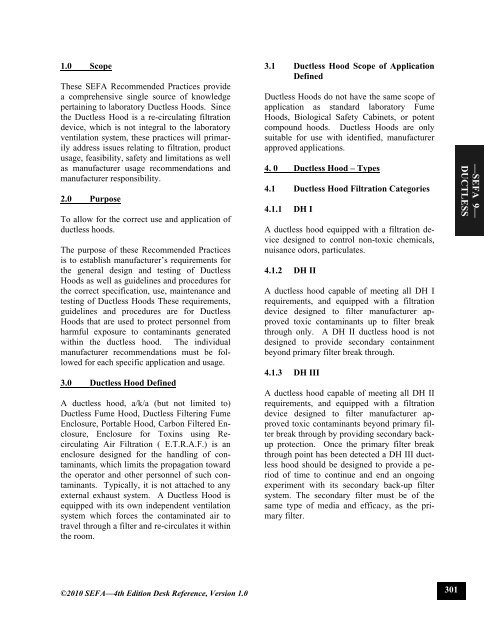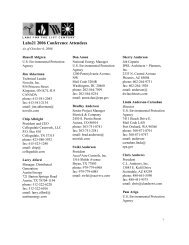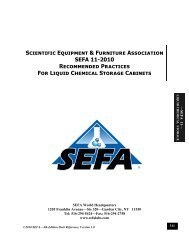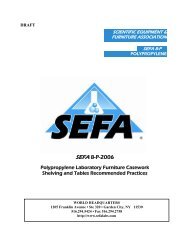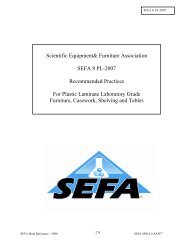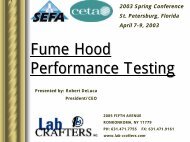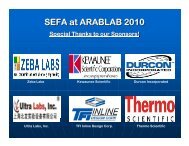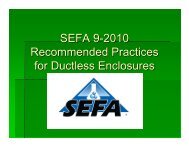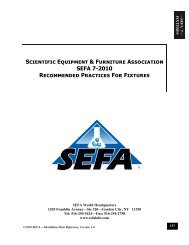Download SEFA-9-2010-Ductless.pdf - Scientific Equipment and ...
Download SEFA-9-2010-Ductless.pdf - Scientific Equipment and ...
Download SEFA-9-2010-Ductless.pdf - Scientific Equipment and ...
- No tags were found...
You also want an ePaper? Increase the reach of your titles
YUMPU automatically turns print PDFs into web optimized ePapers that Google loves.
1.0 Scope<br />
These <strong>SEFA</strong> Recommended Practices provide<br />
a comprehensive single source of knowledge<br />
pertaining to laboratory <strong>Ductless</strong> Hoods. Since<br />
the <strong>Ductless</strong> Hood is a re-circulating filtration<br />
device, which is not integral to the laboratory<br />
ventilation system, these practices will primarily<br />
address issues relating to filtration, product<br />
usage, feasibility, safety <strong>and</strong> limitations as well<br />
as manufacturer usage recommendations <strong>and</strong><br />
manufacturer responsibility.<br />
2.0 Purpose<br />
To allow for the correct use <strong>and</strong> application of<br />
ductless hoods.<br />
The purpose of these Recommended Practices<br />
is to establish manufacturer’s requirements for<br />
the general design <strong>and</strong> testing of <strong>Ductless</strong><br />
Hoods as well as guidelines <strong>and</strong> procedures for<br />
the correct specification, use, maintenance <strong>and</strong><br />
testing of <strong>Ductless</strong> Hoods These requirements,<br />
guidelines <strong>and</strong> procedures are for <strong>Ductless</strong><br />
Hoods that are used to protect personnel from<br />
harmful exposure to contaminants generated<br />
within the ductless hood. The individual<br />
manufacturer recommendations must be followed<br />
for each specific application <strong>and</strong> usage.<br />
3.0 <strong>Ductless</strong> Hood Defined<br />
A ductless hood, a/k/a (but not limited to)<br />
<strong>Ductless</strong> Fume Hood, <strong>Ductless</strong> Filtering Fume<br />
Enclosure, Portable Hood, Carbon Filtered Enclosure,<br />
Enclosure for Toxins using Recirculating<br />
Air Filtration ( E.T.R.A.F.) is an<br />
enclosure designed for the h<strong>and</strong>ling of contaminants,<br />
which limits the propagation toward<br />
the operator <strong>and</strong> other personnel of such contaminants.<br />
Typically, it is not attached to any<br />
external exhaust system. A <strong>Ductless</strong> Hood is<br />
equipped with its own independent ventilation<br />
system which forces the contaminated air to<br />
travel through a filter <strong>and</strong> re-circulates it within<br />
the room.<br />
3.1 <strong>Ductless</strong> Hood Scope of Application<br />
Defined<br />
<strong>Ductless</strong> Hoods do not have the same scope of<br />
application as st<strong>and</strong>ard laboratory Fume<br />
Hoods, Biological Safety Cabinets, or potent<br />
compound hoods. <strong>Ductless</strong> Hoods are only<br />
suitable for use with identified, manufacturer<br />
approved applications.<br />
4. 0 <strong>Ductless</strong> Hood – Types<br />
4.1 <strong>Ductless</strong> Hood Filtration Categories<br />
4.1.1 DH I<br />
A ductless hood equipped with a filtration device<br />
designed to control non-toxic chemicals,<br />
nuisance odors, particulates.<br />
4.1.2 DH II<br />
A ductless hood capable of meeting all DH I<br />
requirements, <strong>and</strong> equipped with a filtration<br />
device designed to filter manufacturer approved<br />
toxic contaminants up to filter break<br />
through only. A DH II ductless hood is not<br />
designed to provide secondary containment<br />
beyond primary filter break through.<br />
4.1.3 DH III<br />
A ductless hood capable of meeting all DH II<br />
requirements, <strong>and</strong> equipped with a filtration<br />
device designed to filter manufacturer approved<br />
toxic contaminants beyond primary filter<br />
break through by providing secondary backup<br />
protection. Once the primary filter break<br />
through point has been detected a DH III ductless<br />
hood should be designed to provide a period<br />
of time to continue <strong>and</strong> end an ongoing<br />
experiment with its secondary back-up filter<br />
system. The secondary filter must be of the<br />
same type of media <strong>and</strong> efficacy, as the primary<br />
filter.<br />
—<strong>SEFA</strong> 9—<br />
DUCTLESS<br />
©<strong>2010</strong> <strong>SEFA</strong>—4th Edition Desk Reference, Version 1.0 301


